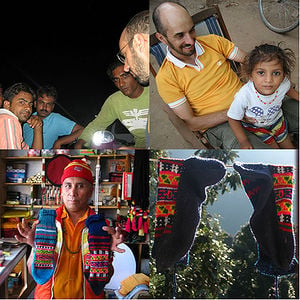[edit | edit source]
ON FEBRUARY 2008 I HAD COMPLETED A YEAR LONG SOLITARY BACKPACK JOURNEY THROUGH RURAL INDIA. SOME OF THESE VILLAGES I VISITED HAD NEVER HAD A FOREIGN VISITOR LET ALONE AN OPPORTUNITY TO BUILD A FRIENDSHIP WITH ONE. TODAY I SHARE THIS LIFE CHANGING EXPERIENCE WITH AUDIENCES THROUGHOUT THE UNITED STATES. I INVITE YOU TO BE NEXT.

India makes one wind down. Some try to see it all in a couple of weeks, that is almost running away from India. Many tours and even backpackers are focused around mega cities, shopping, tourism hubs, pilgrimage centers and historic sites. India's treasure, however, is it's culture and it shines through it's people. The simple daily life of rural villages and towns reveals this reality.
Letting go of a fixed itinerary and merging into the Indian tempo is a key. Otherwise one is likely to grow frustrated: looking at their minimal ways of living as poverty, considering their flexible schedules as incompetence or relating to the natural living as primitive. To really experience the Indian 'Shanti', the liberation of enjoying the moment, one better stop racing for the next. This program is meant to get you there.
What is unique about rural India?[edit | edit source]
===
India, as any other destination, can be traveled on the beaten track. However at cities, towns and even in villages over run by tourism, locals cater to westerners' expectations while their own traditional values erode. At these places money has usually replaced wisdom as the goal in life.
As the safest country I had traveled through, India makes it possible to follow your heart across it, independently. Based on my experience I try to answer the basic frequently asked questions.
Experience what?[edit | edit source]
===
Take a look at the photo & story blog and you may get half the picture. To get the full picture is to be in the picture, to be there.
To start today, check out the Event Calendar and find a presentation-talk or workshop in the right date and place for you or invite one to be shared in your community. All events are at no charge, by donation only.
Here's what people say about My India program and events.
Why?[edit | edit source]
===
Rural India is like an open, real-world retreat. Villages and towns living off the land and within nature where the everyday life is based on values of tolerance for diversity (Muslim and Hindu people live side by side), compassion for even ignorant foreigners (such was myself there). People are kind and keenly welcoming into their homes, lives and hearts with unconditional giving. All of this done with a sense of ease, of a daily sustainable practice.
In such an unfamiliar and isolated environment, yet safe and supportive, I found my self gradually lowering my guards and relaxing into the village state of mind. Doubts became less and less relevant: Is this place safe? Can I trust that person? Why is this person so nice to me? What will it cost me? Why do they talk hindi and laugh in my presence? Is this politically correct? Am I wasting my time here? Do I have a plan for tomorrow?
With time, I was able to realize my own preconditioned mind. Fostered since childhood to be locked in the vicious loop: craving, expectation, stress, anger, revenge, dissatisfaction, boredom feeding back the craving, expectation... and so on forever.
This logic seemed like the default and only possible choice before having the chance to live submerged in this totally alternative reality. Village after village, town after town: the food, clothing, faces changed but the peoples' mindset was always the same. Do the right thing for the sake of that only.
Who?[edit | edit source]
===
Whether you had already traveled India's most busy tourist attractions, bought a commercial package deal, joined a large group organized tour or had never traveled India nor any other country before, this way will let you see another India, the way the essence of India looks and feels like. You may find a village that has no use for your money. It is totally self sustained. A town which dwellers' only chance yet to come in contact with foreigners was by waving the occasional one rushing through on a public bus. A village that has a colorful annual Mela, a holy festival, drawing 50,000 pilgrims, all Indians and you'll be the only foreigner.
Where?[edit | edit source]
===
Before I left for india I was asking for some tips from friends who had already traveled India. A friend of a friend gave me this valuable one I remember to this day: "There's no need for you to ask where to go to, everyone finds his own way through India". As this one proved right time and again, I eventually gave away my Lonely Planet guide book and went on quite freely, accepting invitations from locals I met along the way often on trains, buses and main street.
How?[edit | edit source]
===
Traveling in the traditional Indian way:
Yoga, Mediation, Hindu and Buddhist traditions all request to pass on knowledge without expecting a reward. My India is a not-for-profit program, aims to only cover the basic costs. The nature of traveling in India is very much the same. Rural India provides lifetime benefits that can hardly be understood by one prior to experiencing. Physical comfort may be a notch below western modern life style, however, that will be well compensated by social comfort. Indian often say 'guest is god'. They treat a foreigner like they treat their gods: make you feel at home.